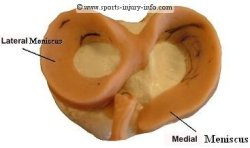Torn Meniscus
A torn meniscus is a common sports injury, because of the high amount of stress that can be placed on the knee during athletic activities. In order to understand a meniscus tear, we must first look at the anatomy of the knee joint, and the role that the meniscus plays.What is the Meniscus

When standing with your legs straight, approximately 50% of your body weight is transmitted through your meniscus. As you squat down, the forces that run through the meniscus increase, up to 80% when your knees are bent to 90 degrees.
During athletic activities that require running, jumping, and pivoting, the amount of force placed on the meniscus increases.
How a Torn Meniscus Occurs
Most meniscus tears occur during some type of twisting motion at the knee. Athletes who suffer a torn meniscus will often describe an injury that occured while pivoting. Remember, the meniscus sits directly between the femur and tibia. As you pivot or twist, you will get some movement between the femur and tibia, and this can often cause damage to the meniscus. These forces are called shear forces, and are usually the main cause of meniscus tears.What To Expect
Most people who suffer from a meniscus tear will describe a twisting type of mechanism of injury. They may describe hearing or feeling a "pop" in their knee. Pain is a very common sign of a torn meniscus.Along with pain, swelling is the another common sign of meniscus tears. This injury will usually cause a joint effusion. This is swelling that occurs within the knee joint. A joint effusion causes the knee to swell up, and is often described as looking like a "grapefruit" or "balloon". The swelling will surround the entire knee, not just one side or the other. Swelling from a meniscus tear usually takes several hours to occur, and is usually noticed the next morning.
Another common sign is the feeling of popping or clicking within the knee joint. Athletes with meniscus tears may also describe a feeling of catching, or feeling like their knee "needs to pop".
When a mensicus is torn, sometimes the tear creates a flap of tissue that moves around in between the femur and tibia. As you flex and extend your knee, this flap may get caught, causing a catching feeling, or it may click or pop as it moves. You may not be able to completely straighten or bend your knee if you have torn your meniscus. This can be due to this flap restricting your motion, and can also be caused by the swelling in the joint.
What To Do
The best treatment for a meniscus tear centers around the R.I.C.E. principles. Because the meniscus is not usually able to heal itself, depending on the severity of your symptoms, a meniscus tear may require surgery. As with most sports injuries, you should seek medical attention from your family physician or certified athletic trainer.Didn't find what you were looking for? Search SII for more information...
Running Pain Solutions
Written for Runners by a runner, you'll learn a holistic approach to improving mobility, restoring normal movement and muscle activation patterns, and restoring the body and mind connection.
This Kindle Book contains a step by step program to keep you running pain free. Included are detailed instructions and illustrations for exercises to improve mobility, balance, neuromuscular control, strength and endurance. Only $7.49!
Get Your Copy Today!
Learn more about treating a torn meniscus









